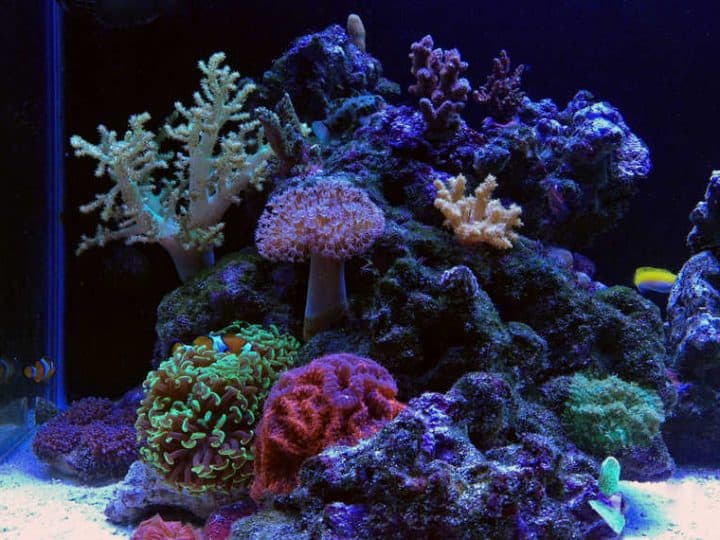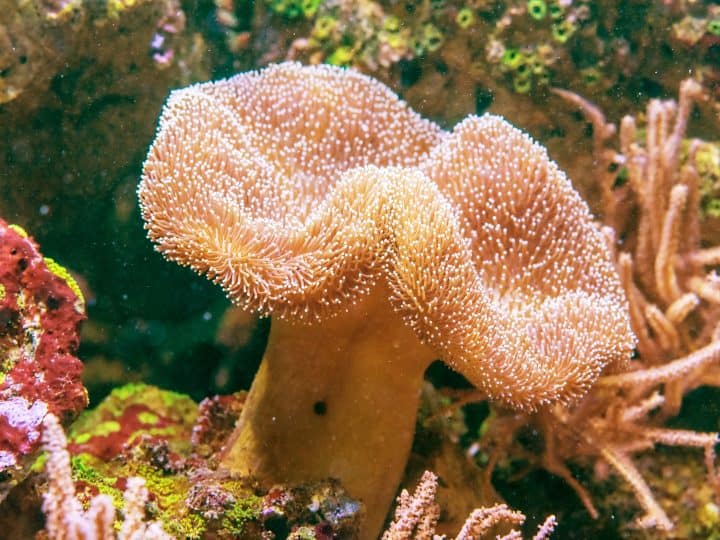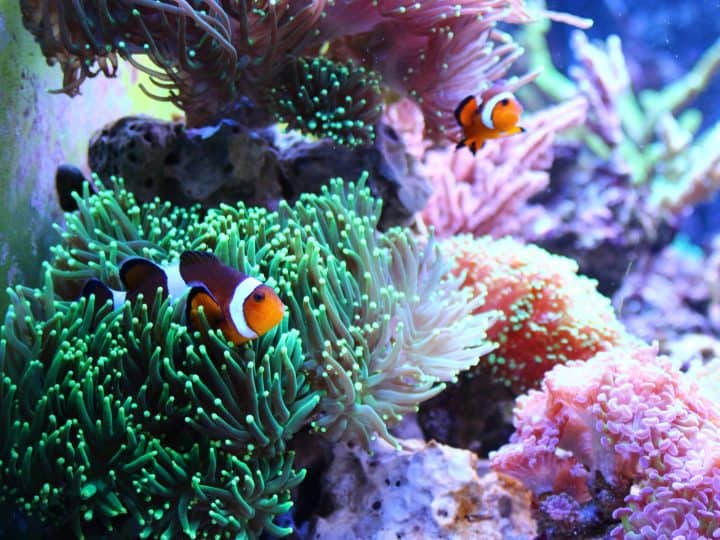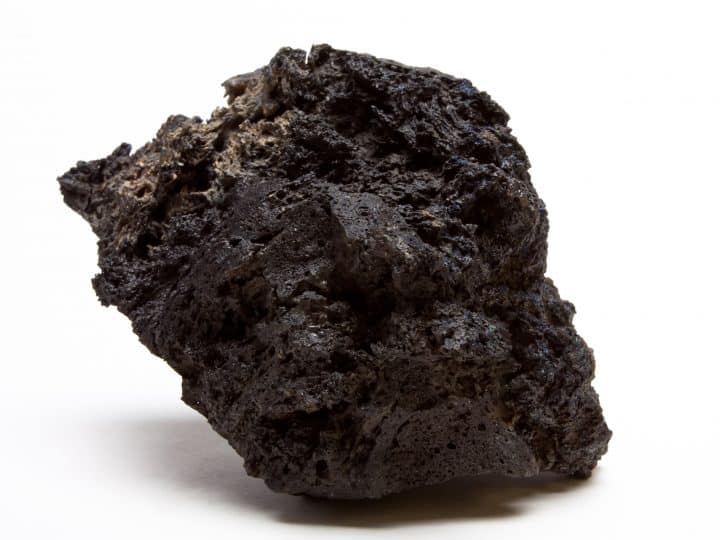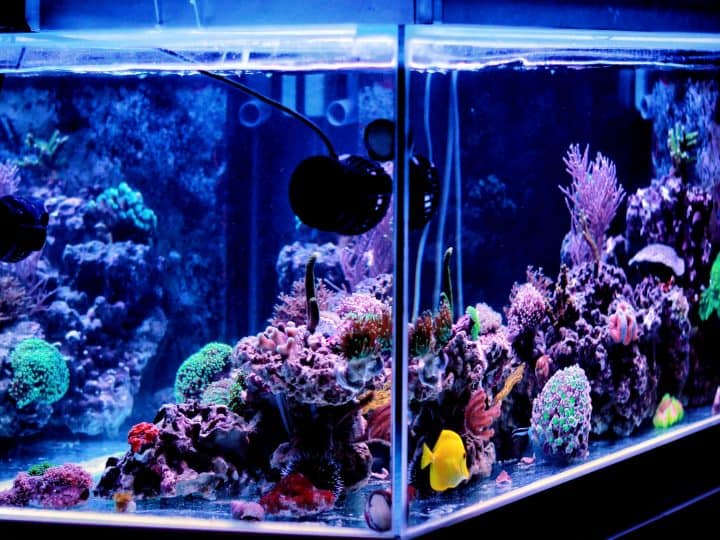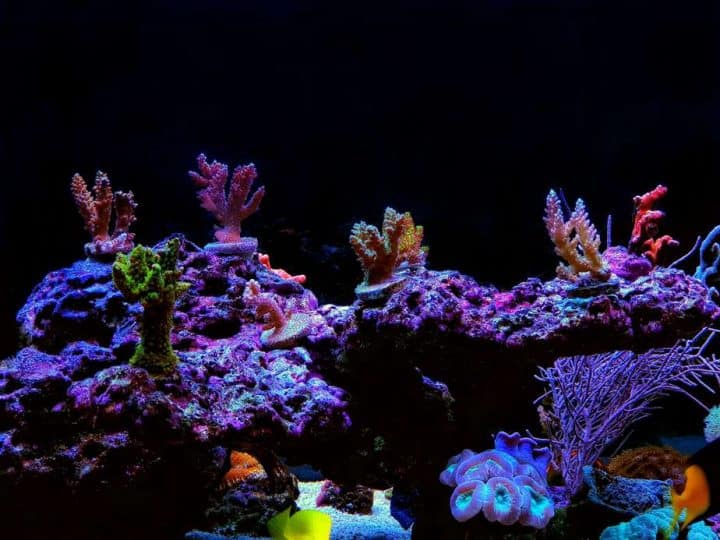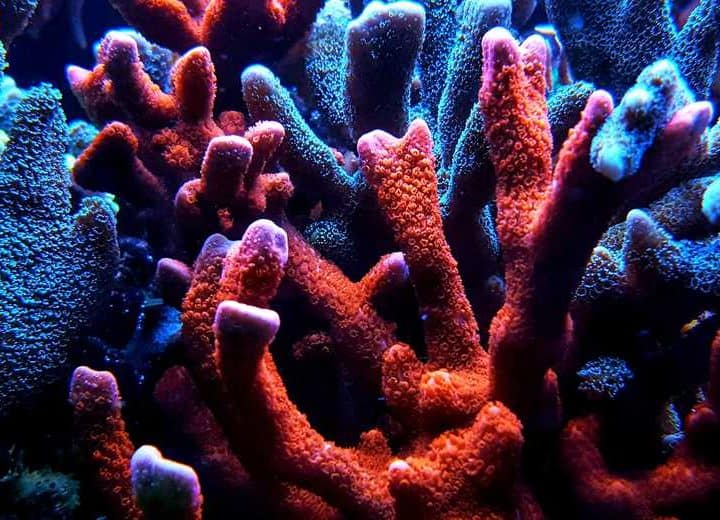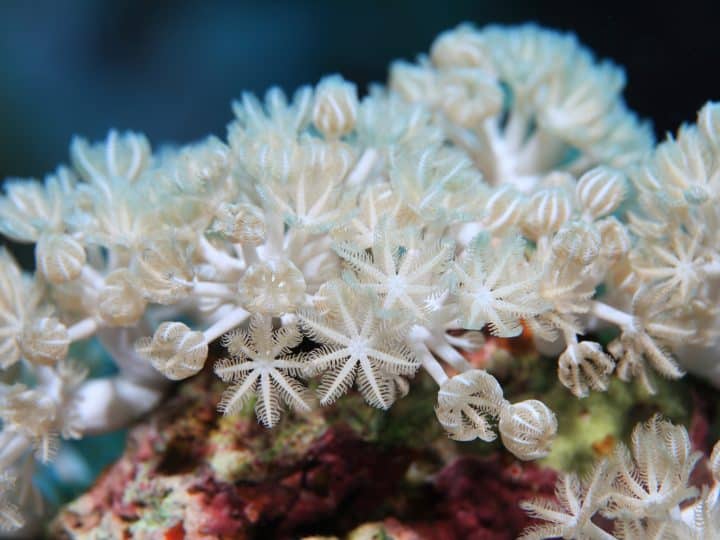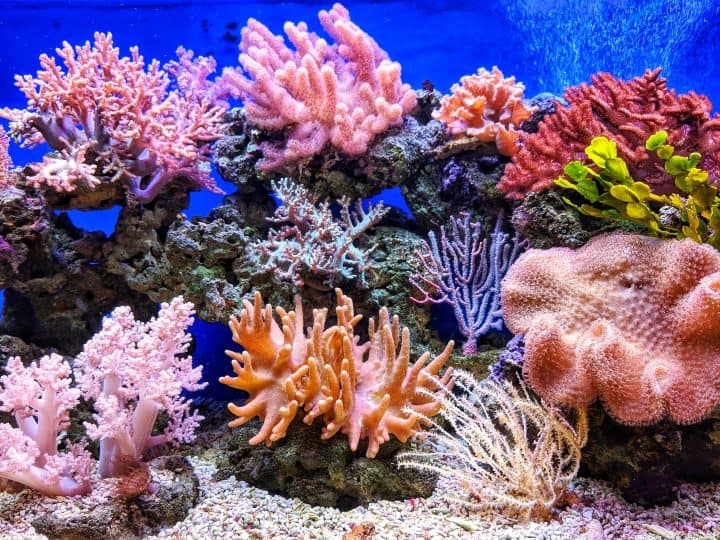Soft corals can be a beginner’s best friend. They are hardy, and most of the species are easy to take care of as a beginner reef aquarist. Due to the absence of hard calcium carbonate skeleton, they are easy to frag. Also, they do not require rigorous maintenance. However, choosing the right soft coral can be baffling as a beginner.
Among a plethora of soft corals species, your best bets are corals like Xenia, Mushroom, Zoanthids, Anthelia, etc. They look dazzling and are extremely easy to care of. Not only these, but you can also consider GSP corals, Colt corals, Finger leather corals, etc.
In the rest of this article, I will talk about 11 easy soft corals that are great for beginners. I will briefly discuss what water parameters they need, requirements of light and water flow, and other basic info. If you are an enthusiast and serious about soft corals, I urge you to stick to the end of this article.
My top 3 soft coral types for beginners
The list of soft corals on this page consist of 11 types. However, to make it a bit easier for you to read, I want to start with my favorite 3 types first.
Let’s dive straight in!
1. Mushroom Corals
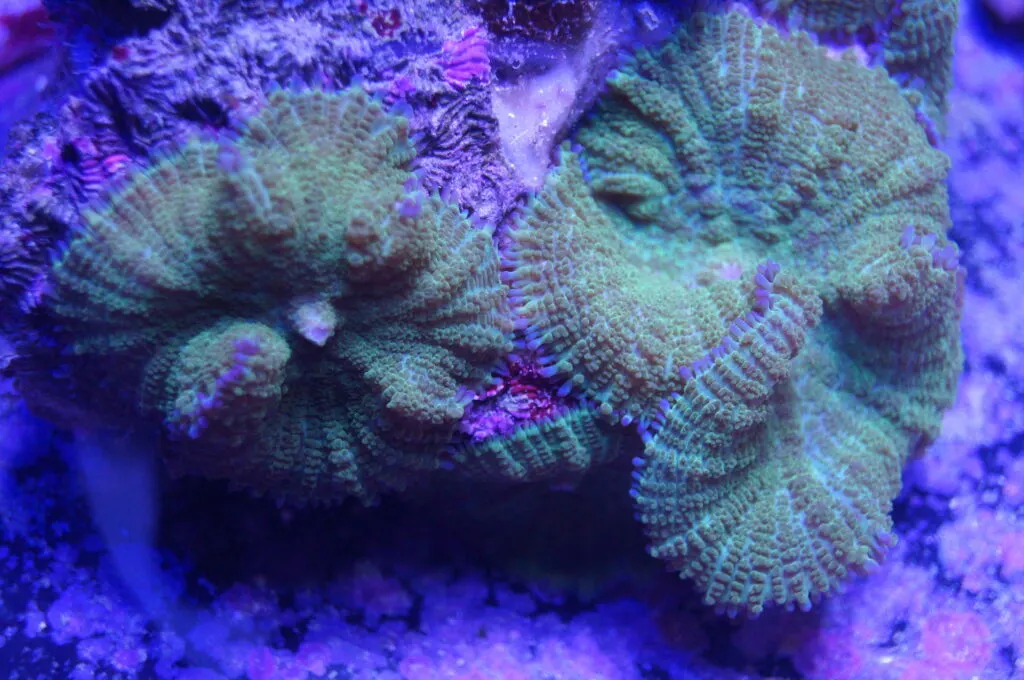
When talking about soft corals, mushroom corals inevitably become the number one.
They are easy to take care of and widely available. You won’t have to comb the online marketplace to find them. You can go and purchase one in any fish store near you.
Mushroom corals require moderate water parameters. Any slight change in the water does not affect much.
Mushroom coral can remain healthy in less than ideal conditions. They are less aggressive and play with others. When placing, any place in the tank is good enough. Just make sure the light is low in intensity, and water flow is moderate.
Do not place them in the same tank with creatures that prey on mushroom corals, e.g., Puffers, peppermint shrimp, etc.
Mushroom corals cannot actively defend themselves from predators. So, placing them near more aggressive coral types will stress mushroom corals, and their overall health may deteriorate. As for feeding and nutrition, that should be the least of your concerns. Mushroom corals make their own food via photosynthesis.
Additional foods like zooplankton are also welcomed.
Mushroom corals procreate by budding, fission, and sexual reproduction. You can also frag them. Keeping a check on their health is easy. When happy and healthy, they expand their polyps. They wither when they are sick.
Right here on my site I’ve also published a list of beginner friendly corals that go beyond just soft corals. That one might also be interesting to you if you’re looking for inspiration.
2. Moon Polyp
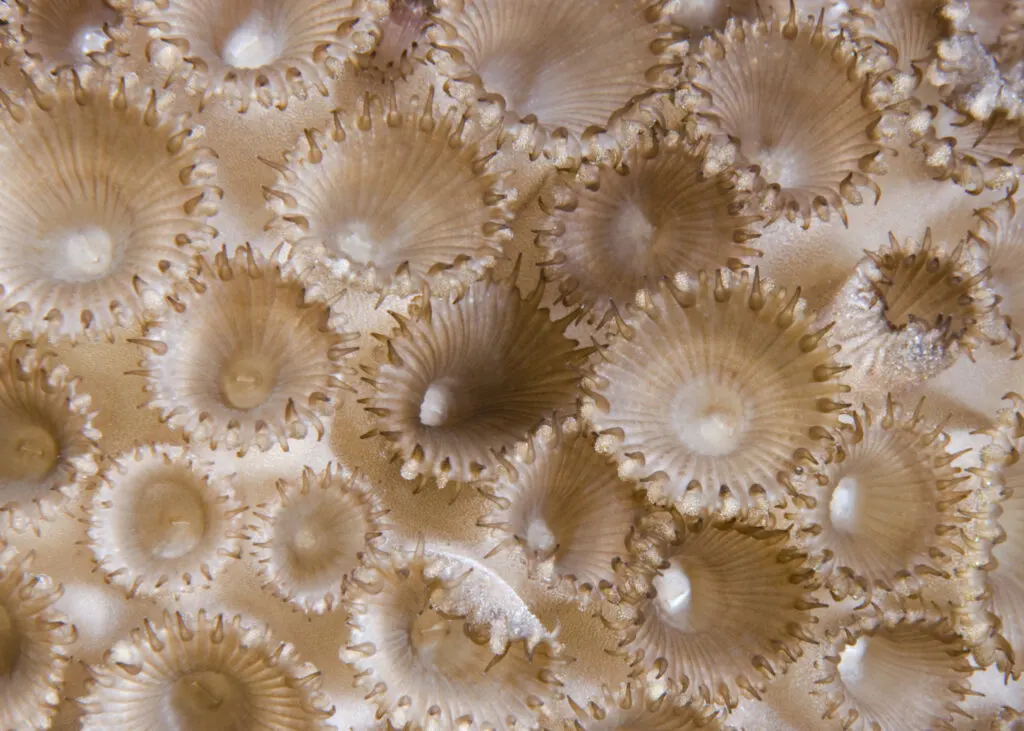
Corals in the Palythoa genus, also known as moon polyps, are a distinctive genus of corals.
They are also known as sea mats. They form a cluster that resembles a half-moon hence the name moon polyp. They are spread on the seafloor like a mat. That’s why they are also called sea mats. These corals are very easy to care for and adored by aquarists of all sorts.
Moon polyps require bright light as they are solely dependent on photosynthesis for food. Note that too intense light may cause a bleaching appearance.
In addition to photosynthesis, Palythoas can feast on small shrimps and frozen zooplanktons. Make sure the shrimps are finely chopped. They can also absorb microscopic food particles shed by other inhabitants of the tank.
Although many aquarists recommend stable water parameters for Palythoas, they can handle subtle fluctuations in water conditions. Besides lighting, they need medium water flow.
You can place them anywhere in the tank as long as they can get enough light and moderate water flow. Palythoas are not aggressive. Make sure to put them away from other engulfing species.
When handling them, be careful of palytoxin. Palytoxin is a potent toxin and can cause harm, especially if you have any gaping wound that the poison can get into.
BTW: this article explains what soft corals are. Might be interesting for you.
3. Anthelia
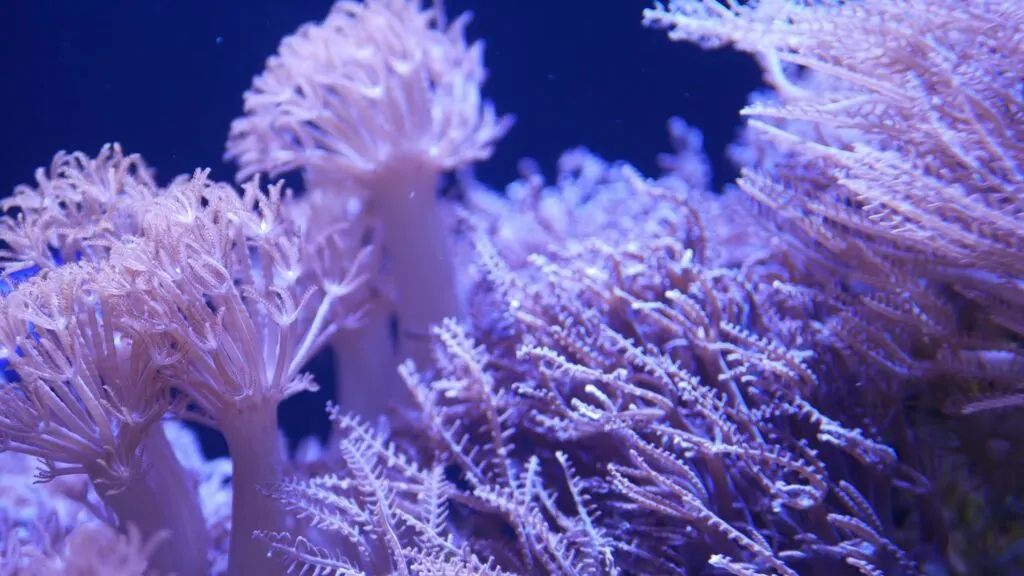
Anthelia is a coral that is equally popular with both expert and beginner aquarists. They have polyps that appear like human hands.
When placed inflow, the polyps sway in a ‘waving hand’ manner. That’s why they are more popularly known as waving hand corals, glove coral, feather coral, etc.
Also, they are available in numerous vivid colors.
Anthelias are hardy and easy to care of. They prefer the bottom place of the tank where both water flow and lighting are medium. They do well enough with photosynthesis, so separate feeding is not that necessary.
Anthelias are encroaching in nature, so placing them with other sessile animals in the same tank is not a good idea.
Optimal water parameters like most other soft corals apply to Anthelias. They do not require anything specific. However, a slight amount of iodine is necessary to neutralize any harmful bacteria, so be sure to maintain that.
If there is no iodine, their normal physiological functions like the waving movement will be hampered.
Anthelias are easy to propagate. As they tend to engulf their surroundings, propagation is a must for them. Another thing to know is that they are often confused with pulsing xenia corals. They are completely different from each other.
More easy soft corals for beginners
Now let’s move to the remaining 8 types of soft coral that you can keep in your reef tank!
4. Pulsing Xenia
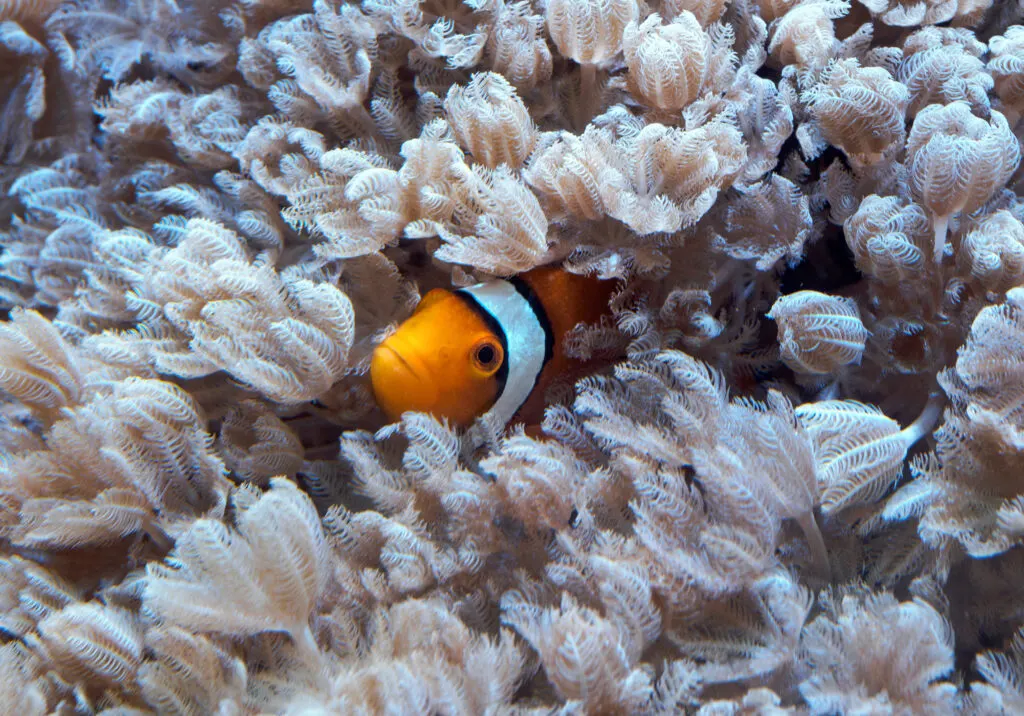
Pulsing Xenia, Pulsating Xenid, Pom Pom coral; this soft coral species is known by many different names.
It grows fast, can grow anywhere, and doesn’t require anything in particular to thrive. In a blink of an eye, they can take over your entire tank, and the coral will leave nothing. But don’t worry, they are also very easy to frag, doing justice to soft corals.
I’ve compiled a list of corals that are easy to frag, which you can find here if you’re interested.
Pulsing Xenia corals do well in low water flow and lightings. So, you won’t have to arrange anything special if you plan to bring in a bunch to your home.
As for the water parameters, they do reasonably well in normal conditions. Xenias are photosynthetic but get their food mostly from water columns and organic particles shed by other tank habitants.
Pulsing Xenia is peaceful in nature, so you can put it in the tank with other species. When placing, make sure that it is not in a spot that you don’t want to get occupied at a moment’s notice. Yes, it grows ridiculously fast.
And because of this nature, pulsing xenia is one of the best corals for fragging.
Its appearance is the most appealing aspect. Its polyp appears like human hands. Even without any water flow, the polyps open and close, resembling a pulsing rhythm. This phenomenon gives it the name pulsing xenia.
5. Kenya Tree Soft Coral
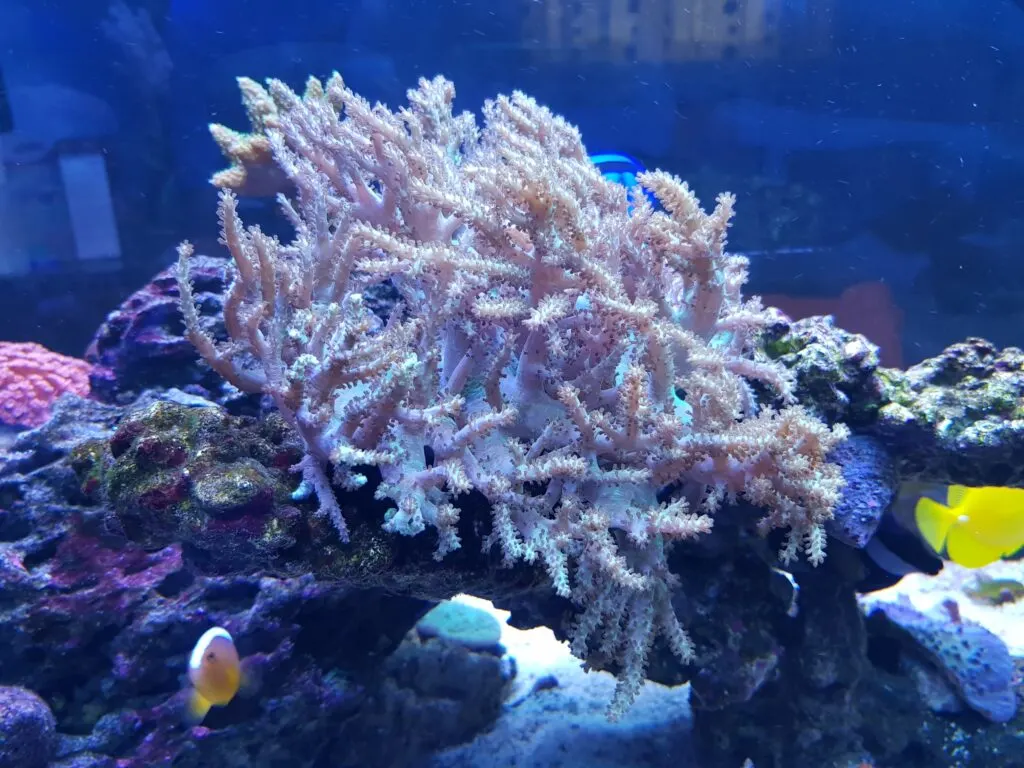
Kenya tree coral is also known as cauliflower soft corals. But do not confuse them with cauliflower corals; they are two different species. It is generally available in brown or pink colors.
There are rare species of Kenya tree corals that exhibit greenish coloration. However, this variety is rare and pricey.
This coral is also on my list of coral that’s suitable for seahorses. If you’re looking for seahorse-related inspiration, check out the list here.
This coral needs strong water flow and intense lighting compared to other soft corals. It also requires high pH, alkaline, and calcium levels, while phosphate and nitrate levels should be zero. But any slight mishap in the water parameters doesn’t have any drastic effect on this coral’s well-being.
Kenya tree is a fast grower, so fragging and propagation can be done as your wish.
Kenya tree coral is slightly aggressive but not enough to be considered a threat to other species. So, you can have it in the same tank as other creatures.
It is photosynthetic but dependable on supplementary feeding. Weekly feeding of plankton will help to improve its health. Additional trace elements in the water are proven to be beneficial as well.
6. Green Star Polyps (GSP)
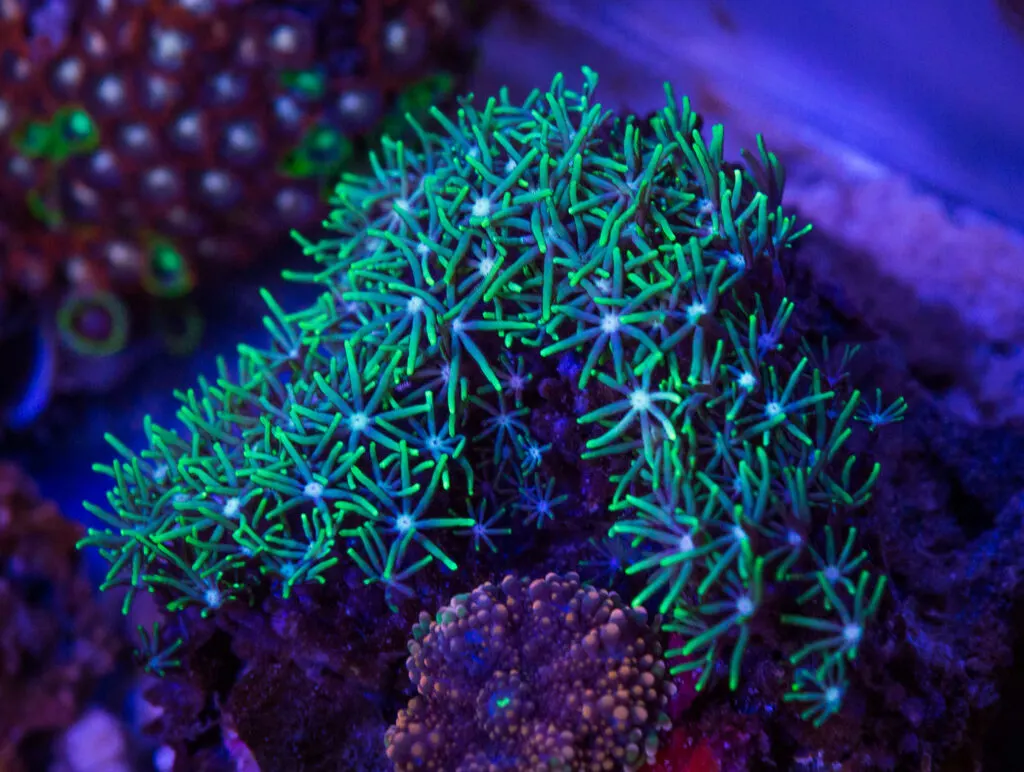
Green star polyps are an amazing soft coral for beginners. They appear as a carpet of green grass on the floor.
Although the name suggests their color, they can also be brown or purple white. They also have a touch of purple on them, depending on the species. They are hardy, easy to take care of, and grow lightning fast.
I’ve written a species specific guide on GSP, which you can find here.
They require medium to high lighting and water flow.
Like any other hardy soft corals, there is nothing exaggerated in the water parameters. Green star polyps are not aggressive and do not attack others. But as they grow very fast and tend to encrust other sessile creatures, maintaining a fair amount of distance is recommended.
Green star polyps grow fast, so they have excellent fragging potential. You can frag them to sell or trade with someone.
They are photosynthetic, so additional feeding won’t be a concern for you. If they need additional nutrition, they can take it from the water column and other food particles left by fish, crabs, etc.
One important troubleshoot to remember is that they might react harshly and stop their natural opening or closing functions due to tweaking in salt content.
Just keep your water clean to avoid this sort of event.
7. Colt Coral
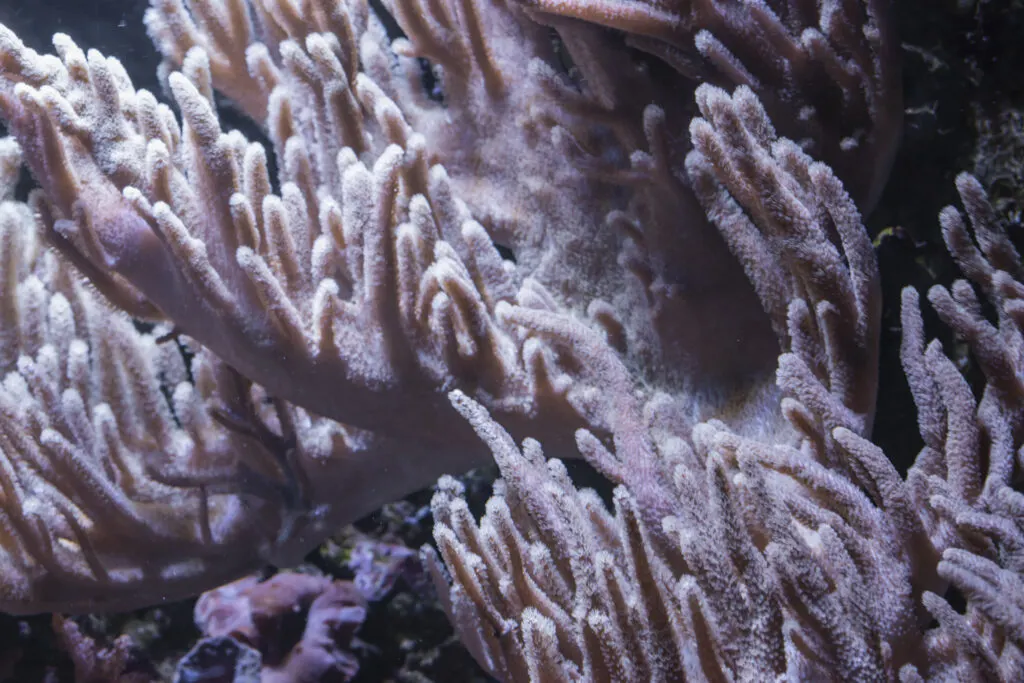
Colt corals are relatively more aggressive than others on this list. But that doesn’t stop it from being one of the top choices for beginners.
Any newbie hobbyist can take good care of it. It prefers to be in high current and intense light but also does well in moderate light and flow. It can be placed anywhere in the tank as long as the least amount of flow is present.
Click here for my care guide on colt coral.
As for diet, if you can place colt corals in intense light, you won’t have to provide additional food.
It will make its own food by photosynthesis. But if the lighting is mild to low, you should provide supplementary food for their nourishment. Baby shrimps, zooplanktons, etc., are well-favored by colt corals. Just chop them finely beforehand.
One thing you must remember when placing them is to keep them away from leather corals and Sarcophytons. Colt corals will instantly slaughter them.
In addition to food supplements, giving extra amounts of trace elements will exceptionally improve their health condition.
8. Sinularia
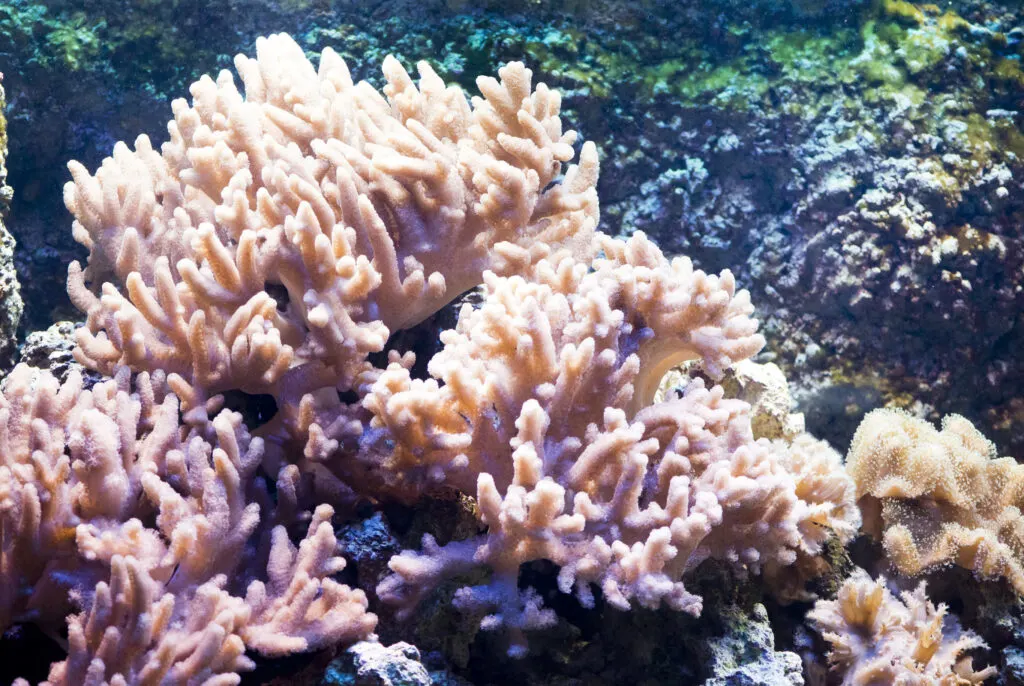
If the name seems a mouthful for you, I’m going to make it easy for you. They are also known as leather corals. They are hardy and tough, making them a competent candidate for beginner soft corals.
They can tolerate moderate to high water flow and lighting. Water parameters are nothing special as they can withstand large swings in the water elements.
If you are only considering water conditions, you can place it anywhere in the tank with moderate light and water flow. I’ve written a more detailled guide on deciding where to place leather corals. You can find that one here.
As for other species in the tank, leather corals pose a threat to them.
They have a very effective defensive mechanism. They can sting other creatures with their polyps and emit chemicals to repel any threat. So, try placing them at a distance.
You can feed it zooplankton or micro planktons or let it grab its own food from tiny food particles in the tank. Or you can do nothing as leather corals are photosynthetic and can make their own. If you opt for the latter option, make sure there is adequate lighting accessible to the coral.
Leather corals grow pretty fast, so they are a good option for fragging. Also, if you want your tank full in no time, they are a good option.
9. Toadstool Coral
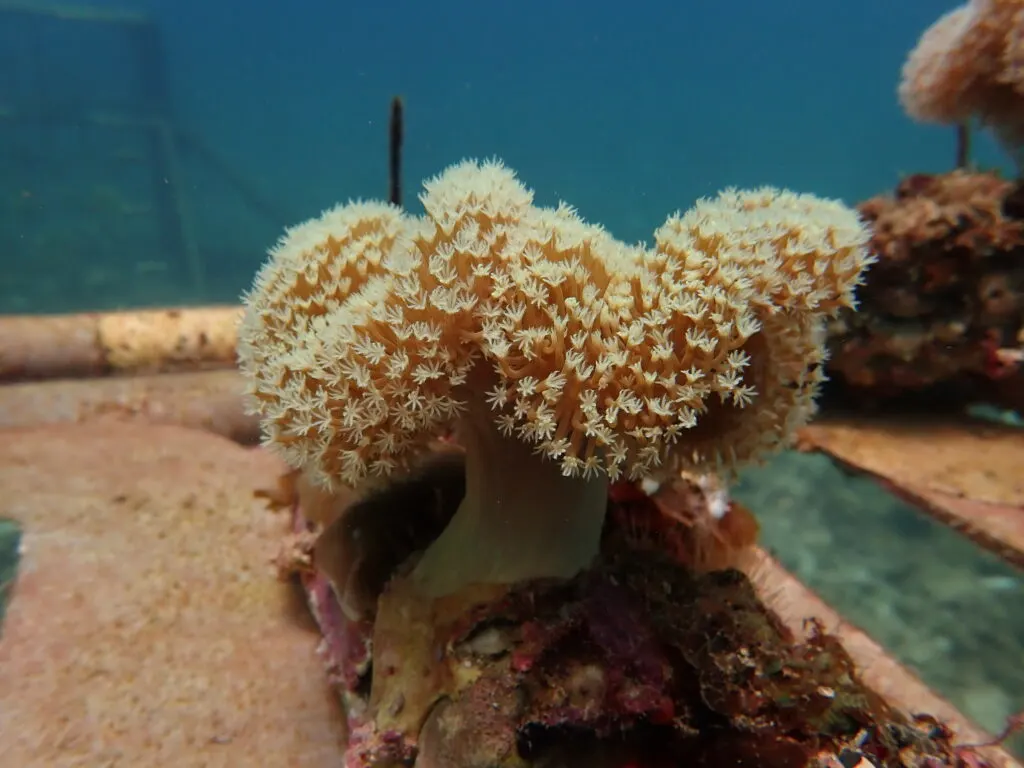
If you have set up a reef tank for any purpose, toadstool coral can be your guest. They are one of the most resilient soft corals that you can ask for as a beginner. They have many varieties, and all of them are equally popular with aquarists.
None of them have any shortcomings, so you can choose any.
They are photosynthetic, so that leaves you one less aspect to worry about.
Many aquarists claim that toadstool corals are particularly benefited from additional trace elements, but they do just fine without anything supplemental.
Toadstools are peaceful corals and make great tank-companions. But they release some chemicals due to metabolic processes, which retards the growth of small polyp stony (SPS) corals. So, watch out for those.
Toadstool corals need medium light and flow, so you can place them almost anywhere in the tank, just away from powerheads.
Colonies of toadstools grow quite fast, so you can resort to fragging to keep them at bay. If you have other members in your reef tank, great news for them as toadstool corals are a great anemone surrogate for Clownfishes.
They go through a shedding process where they appear to be sick, but don’t be alarmed. It is a completely natural process.
10. Finger Leather
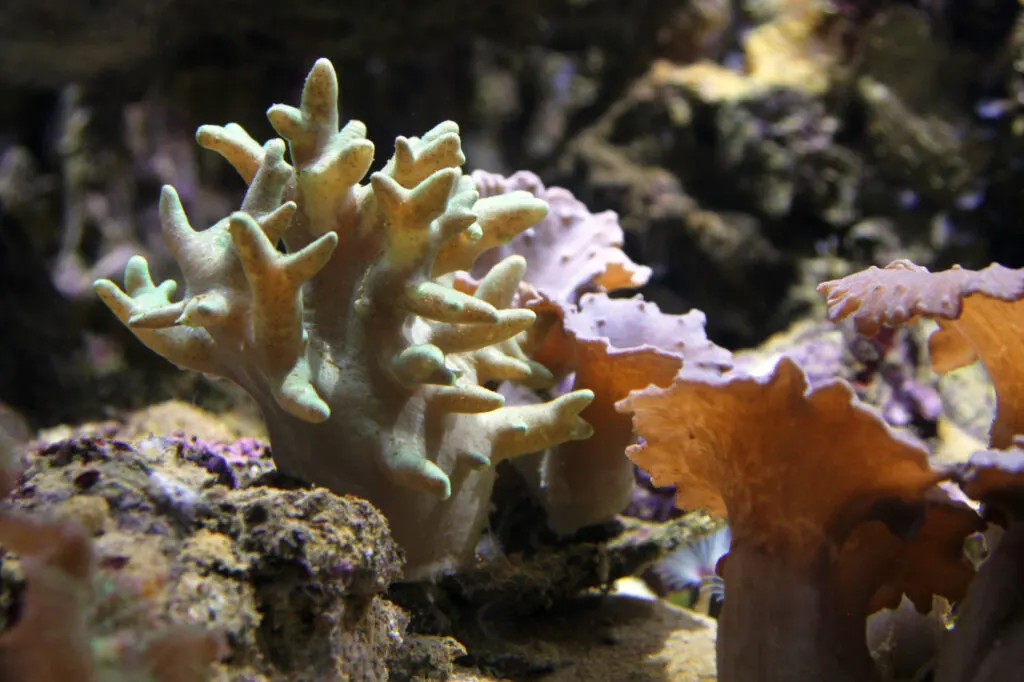
Finger Leather corals are available in various colors like brown, green or golden.
They require moderate care, which is nothing excessive. So, picking them as a beginner won’t be something you regret. They share a resemblance with mushroom corals, so look closely before buying.
They require high water flow and light but can settle for mediocrity. Water conditions and parameters are like any other soft coral species. Only some extra trace elements can make their life a lot better.
When placing, make sure you place them anywhere between the middle to the bottom of the tank.
Finger leathers are not aggressive and not known to be mean toward other species. But like toadstool corals, they release some toxins as the end products of the metabolic process, which can be harmful to other corals or fishes in the tank.
They are photosynthetic, so additional food supplements should be out of the list.
11. Clove Polyp Coral
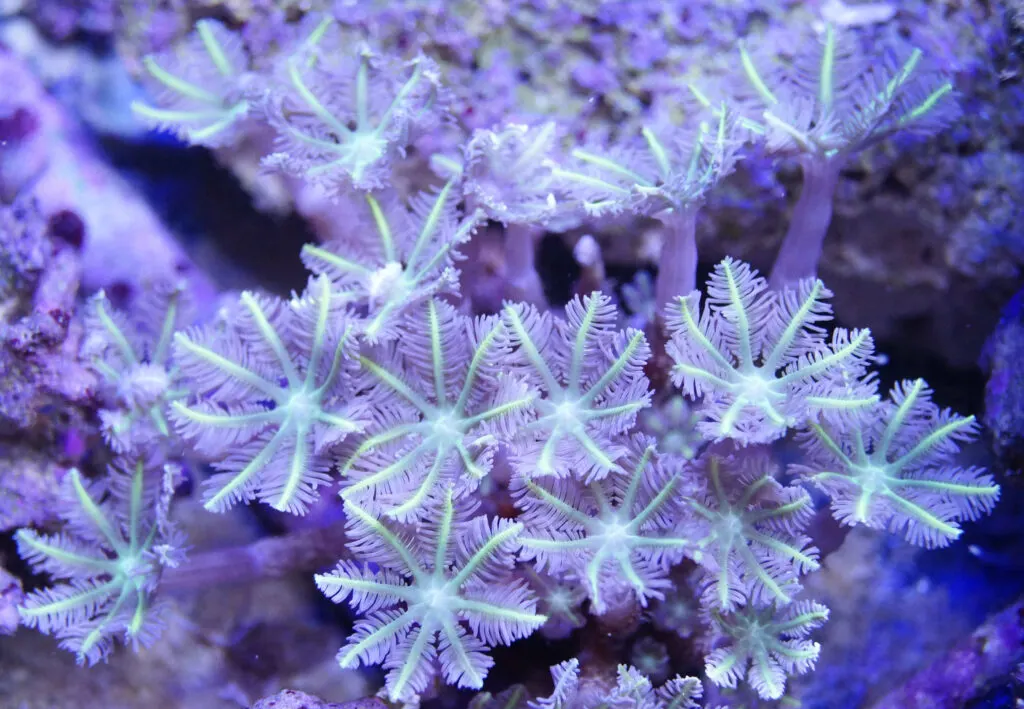
Clove polyps are an exceptional coral for aquarists.
Both beginners and experts prefer this soft coral as their get-go. They can do well in a wide range of lighting and water flow. But try giving them some extra flow if you have powerheads in your setup. This will give you an amazing view while keeping the colony clean.
Clove polyps are photosynthetic, just like any other on this list. But you can give them additional foods like rotifers, Krills, etc.
Buy them frozen from stores and chop them up before serving.
One thing that is different with this particular coral is that it grows slowly. If you want to frag, clove polyps aren’t your thing.
However, they respond very well to propagation. Once they grow enough to propagate, you can frag them to grow a different colony or trade with a friend.
When placing, place them away from other aggressive corals to allow them to expand freely. If you want to boost their growth, add iodine and other trace elements to the water.
Picking the right corals can be daunting, especially with this much choice. If you need some tips and pointers on how to find out what corals are best for your tank, this resource might help.
What have we learned about soft coral?
Corals are beautiful. Soft corals are even more because they show off that signature ‘swaying’ movement, thanks to the lack of a hard skeleton. I’ve made a list of corals that add movement to a reef tank, which you can check here.
They are tough and resilient, just what you need as a beginner. Lack of experience and knowledge makes it difficult to choose the right one. But there’s a first time for everything, and that is where this article is aimed towards.
In addition to waking you through the 11 easy soft corals that are great for beginners, I tried to explain everything you need to know about soft corals.
Especially, Light intensity and additional food requirements often seem to perplex newbie aquarists. So, I have particularly emphasized those topics.
I am highly confident that this article is competent enough to be your guide to find out the best soft corals for your reef aquarium.

